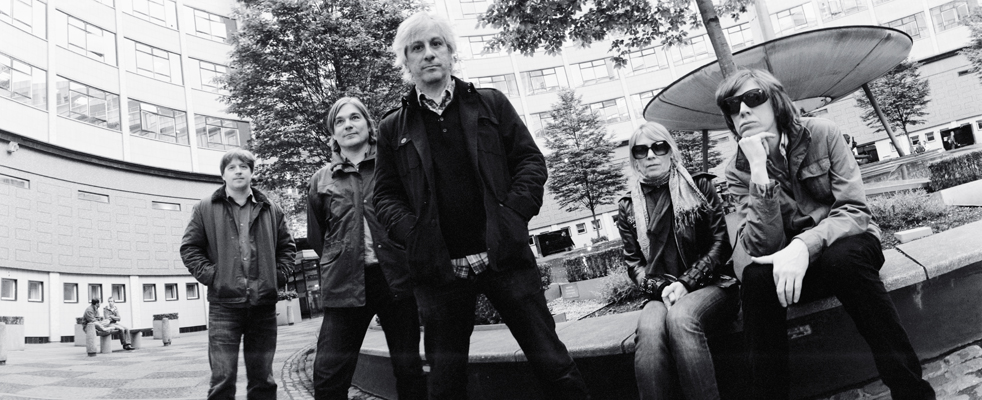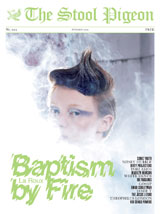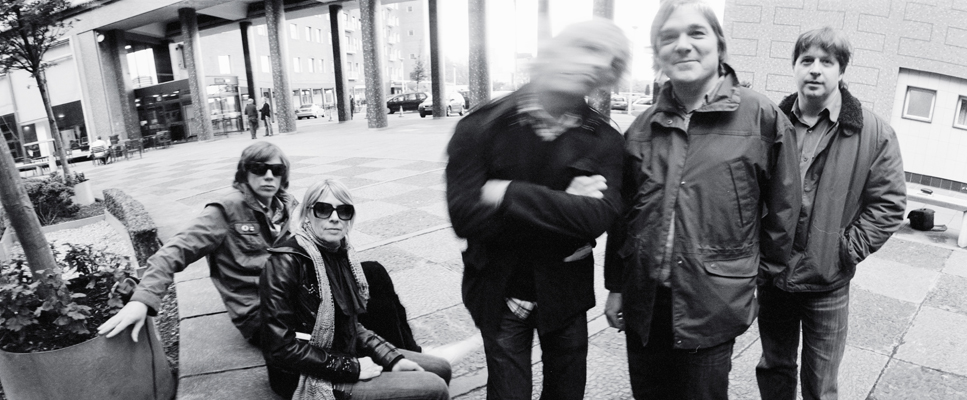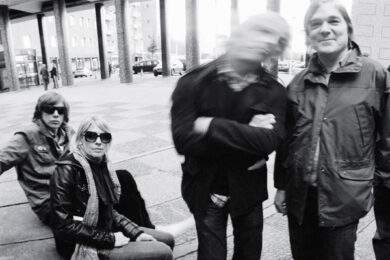Late April and Sonic Youth have just finished their first rehearsal for Later… with Jools Holland, unaware that tradition dictates they’ll have to join Depeche Mode, Lily Allen, blues legend Taj Mahal and US soul singer Raphael Sadiq in a boogie woogie jam to open tonight’s prerecording of the show.
"Are you serious?" asks Kim Gordon from behind her big dark shades.
"It’s a forced weird party vibe thing," Mark Ibold informs her, and he knows: his alma mater Pavement were forced to play along with Jools Holland and Co. back in the 1990s.
Sonic Youth were on Later…‘s first series, before the opening trial by piano and portly gent in jacket had been invented. Then, a slimmer Jools called them a "rude sound" before they played ‘Sugar Kane’.
"I don’t remember doing it last time we were on," says Thurston Moore with a disbelieving tone. "We were on, like, the sixth episode. It has to be boogie woogie? I’ll boogie woogie with him."
There was no boogie woogie at the Scala in King’s Cross the night before, nor the interminable jamming that often marks/mars Sonic Youth gigs. Playing their most intimate UK gig in years, the band ripped through new album The Eternal and a greatest hits set to a rabid reception. "Sonic Youth are the best thing in the entire fucking world!" screamed one fan. Others gazed upon the racks of guitars on either side of the stage in awe. It can sometimes hard to quite understand the level of devotion that Sonic Youth engender. They might be loud as hell and unimpeachably hip, but all too often there’s something curiously detached and overly self-aware in their music. At their worst, they fall for the most unfortunate kind of pompous self-indulgence, be that Kim Gordon walking in muddy boots along her bass at Glastonbury in 1998, or the onanistic doodling of last year’s retrogressive Daydream Nation Don’t Look Back concerts.
The Scala gig, though, couldn’t have been further removed from these two extremes. Like much of The Eternal, the set was punchy and abrasive, and it was telling that Sonic Youth played three tracks — ‘Brother James’, ‘Making The Nature Scene’ and ‘She Is Not Alone’ — from their earliest days in New York. Inspired by the brittle sounds of no wave on one hand and Glenn Branca’s guitar experimentation on the other, Sonic Youth were formed by Thurston Moore, Lee Ranaldo and Kim Gordon in 1981 (current drummer Steve Shelley joined in 1985), releasing their first record, the Sonic Youth EP, on Branca’s Neutral Records in 1982. Largely ignored in their homeland, Sonic Youth began to pick up support in Britain and Europe, with Paul Smith’s Blast First releasing their second album Bad Moon Rising in 1985 and continuing to distribute subsequent LPs in the UK until the band signed to the major Geffen Records to release Goo in 1990. A marked departure from the psychedelic noise of its predecessors, Goo was arguably Sonic Youth’s first out-and-out pop record, and it was followed in 1992 by Dirty, which upped the commercial ante and followed a tour alongside Nirvana.
After Dirty and its follow-up, Experimental Jet Set, Trash and No Star, Sonic Youth retreated from the upbeat post punk-influenced sounds that brought them their greatest success. Still on Geffen, they began to release a series of largely instrumental pieces on their own SYR imprint alongside their studio albums. Jim O’Rourke joined the core quartet for the release of Murray Street (2002) and Sonic Nurse (2004), only to depart and be replaced by Ibold in 2006. Rather Ripped, released that year, was Sonic Youth’s last album for Geffen before they signed to Matador and returned to the shorter tracks and poppier dynamics that characterise The Eternal.
It’s perhaps wrong to read too much into the band’s decision to return to the independent fold. The Eternal material had its genesis long before the band signed to Matador and Sonic Youth have never shied from trying to infiltrate the mainstream by any means possible. Indeed, from album artwork to lyrical subject matter and song titles, they’ve attempted to subvert the iconography of America, of rock ‘n’ roll and pop culture, bringing together high and low via the medium of feedback and peculiarly tuned guitars. Whatever the case may be, the Scala performance was that of a band full of vigour and vim and clearly relishing the opportunity to demolish such a small venue. Afterwards, Thurston Moore lolloped around the aftershow like an overgrown teenager, and Lee Ranaldo chatted to Nick Zinner before being taken off to meet renegade Special Jerry Dammers.
If only their enthusiasm had extended to the interview the next day.

Tuesday morning, 11am. Sonic Youth have finished their first Later rehearsal and want to go to Shepherds Bush’s gleaming new Westfield shopping centre. Steve Shelley, however, opts to stay behind in the BBC dressing room, which resembles a hotel that was last expensive in the 1970s.
"Steve doesn’t go to malls with journalists," says Lee Ranaldo. "He doesn’t like them to see the kind of store he goes to. That’s what it is. The kind of store he gravitates towards is not very rock & roll. I can’t tell you where he goes, though, and Mark . . . Mark’s the one for cookware."
"Since he joined the band he’s always been decked out in gothware," quips Thurston Moore, about Sonic Youth’s newest member. "He likes to shop in Hot Topic."
Thurston Moore heads towards Foyle’s in search of a couple of books, though he’s trying to curtail his hoarding habit. "I did used to collect books, but I’m trying not to collect anything any more. Reasons of space, and I think it’s offensive given the state of the economy," he explains. "I want to get rid of a lot of stuff. I’ve always been into collecting records and books and other ephemera. I want to do a real purge but it’s hard, unless you get a collector to come and rock away with everything. I could set up an eBay store, but then I’d have to stop touring."
Kim Gordon, who is 56 today, doesn’t seem to want to be doing an interview. She’s already made it known that, because there’s no make-up or stylist on hand, she’s not going to have her photo taken. Apparently yesterday’s press day was a bit wearing. "We’re kinda sick of photos," she tells the snapper, Dave. In her blue jeans and effortlessly expensive-looking black leather jacket, she strides off towards Top Shop, a favoured UK stop-off for the full-time musician and part-time fashion designer.
Lee Ranaldo, on the other hand, wants to go to HMV to hunt out some DVDs. Gliding up a silver escalator, the check-shirted guitarist spots a mall staple. "We did a record with Starfucks . . . er, Starbucks," he says. "It’s interesting because it was kind of a compilation — celebrities picking their favourite Sonic Youth songs. When we put it together we thought it was going to be the biggest sell-out of our career. At the time we did it, Starbucks was the only company in America that had figured out how to sell records when all the labels were falling on the floor. But by the time ours came out . . . it’s the rarest record we’ve ever released. It’s impossible to find in the shops. I don’t know how many they made — literally a few hundred."
Ranaldo is looking for a particular Japanese animation DVD. "It’s ostensibly for my kids," he says. "Someone told me it was out in Britain and not anywhere else. It’s the new Hayao Miyazaki — his last movie — I can’t remember what it’s called. I wanted to get the new Dylan album, but that’ll be cheaper at home. Oh, they’re playing the Dylan."
He spots chic terrorist flick The Baader Meinhof Complex. "There’s another terrorist porn film that we were into recently. It’s called Eight Miles High [2007 German film, Das Wilde Leben]. It’s about a German commune where this beautiful girl becomes a real famous model. She became the face of this German commune — a free love commune."
His shopping habits reveal typical Sonic Youth shtick, the sort of thing that’s influenced and been explored in their work from their earliest days until now: ultra-violence, cults and mass murder translated into a stylish, well-executed aesthetic.
"I don’t go to the mall back home," says Ranaldo, waiting for an AWOL Moore and Gordon, "but we should have had the four of us in some terrible mall setting. We can do photos of the men of Sonic Youth in the women’s lingerie section of that store."
But Kim Gordon, it appears, is still not keen to have her photograph taken, and the chance to snap the men of Sonic Youth in pantyhose is spoiled by over-zealous security guards.
The lanky guitarist and singer returns with a copy of Michael X: A Life In Black And White and a very obscure looking novel with a sleek, minimalist cover. His plans for an end to hipster hoarding have clearly gone awry, and he tucks the books under his arm as he walks down the wide new road back to Television Centre.
"I can sort of see a relationship between some of The Eternal and Dirty in terms of the dynamic," he says when asked if the new record is a nod back to Sonic Youth’s more pop-orientated moments. "We definitely wanted to make songs as opposed to doing an avant-garde opus. That was one idea we had, now that we’re on Matador: to do just one unending composition — something really radical. But we decided that they’re really strong song-supportive label, so we hadn’t practised doing that to such a degree last time around."
"It was interesting that we’d just done the Daydream Nation shows — revisiting these songs that the four of us had done together in our early trajectory," Ranaldo interjects. "Some of those songs had an energy that we’d kind of forgotten about, and some of that energy and the experience of doing those songs impacted on the new record. We’ve been really into what we’ve doing over the past few records, but it hasn’t been that full-on or in-your-face, balls-to-the-wall thing. We swing from record to record and, like Thurston said, the next record might be one long 20-minute piece on each side. It just kind of goes back and forth – we don’t plan too much."
Was it good doing something new after the Daydream Nation gigs?
"What’s cool is we’ve gone through this period with Jim O’Rourke where we were this real solid quintet, then we came down to a quartet, which we hadn’t been for almost 10 years and did Rather Ripped," Ranaldo explains. "Immediately after that we revisited Daydream as a quintet, and those two points were pretty instructive. We were happy with Rather Ripped, but we were also pleased with what we were doing with Daydream. It’s like a snapshot of ourselves over three different periods."
Back in the BBC studio, it’s time for Sonic Youth to run through their rehearsal to camera. A runner sits peeling labels off of bottles of Becks, and replacing them with Later… branded stickers. Except he’s got the wrong series, and has to do it all over again. The bottles of beer are empty. Onstage, Sonic Youth are a machine. Guitars are picked up, they plug in and, bang, ‘Teenage Riot’ blasts across the studio. Serious-looking operators in black combat trousers swing camera booms or scurry around the studio floor at the behest of a bolshy looking lady wielding a clipboard. Lily Allen appears in scruffy jeans, gives a thumbs up and sits, nodding along. It might be part of the routine — a gig for technicians and a few people sat around the back of the room — but Sonic Youth look as if they’re enjoying themselves up there. "Earth to guitar player," jokes Moore when Ranaldo makes a mistake. When the rehearsal’s done, said guitar player makes sure he takes time to thank the floor manager before Sonic Youth hop across in front of Lily Allen and back to their dressing room.
There’s some furtive whispering and urgent discussion between Ranaldo and the band’s manager. Sonic Youth and entourage gather in the hallway and it transpires that, finally, Kim Gordon has deigned to join the rest of her band in a quick photoshoot. Everyone troupes outside to the hallowed courtyard of BBC Television Centre to be snapped in front of T.B. Huxley Jones’s statue of Helios, Greek god of the sun. The west London sun has disappeared behind ominous-looking grey clouds and a light drizzle falls as, a roll of film exposed, Sonic Youth clamber into limos. Mark Ibold is off to the Sir John Soane museum and Seven Stars pub. Thurston Moore, ever the big kid, wants to go to a fancy hotel for a cream tea. "Clotted cream, scone, English tea and tequila slammers," he cries.
A few hours later, and Sonic Youth are back in the studio that crackles with the tension of live telly. Jools Holland calls for a riff from Raphael Sadiq’s guitarist to start the boogie woogie jam. Thurston Moore humps the amplifier with his guitar. Lee Ranaldo attacks his with a drumstick. Kim Gordon, in a short skirt that few women her age would dare to wear, batters massive rumbles from her bass. From the other side of the studio, the noise is at atonal odds with the session muso wibbling from the other groups. Sonic Youth clearly still know how to make the "rude sound" in the hallowed court of Jools.
When the show is aired a few days later, the camera pans around the room: Raphael Sadiq, Taj Mahal, Depeche Mode, Lily Allen, now in a little black dress. Sonic Youth’s exertions towards a rambunctious disruptive intent are visible but, curiously, none of the sound they’re making can be heard through the television speakers.
This article originally appeared in the most fabulous Stool Pigeon. To find a list of stockists visit StoolPigeon.co.uk here.




